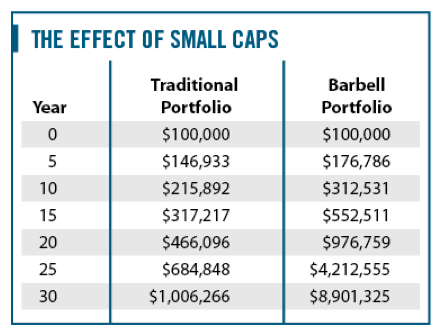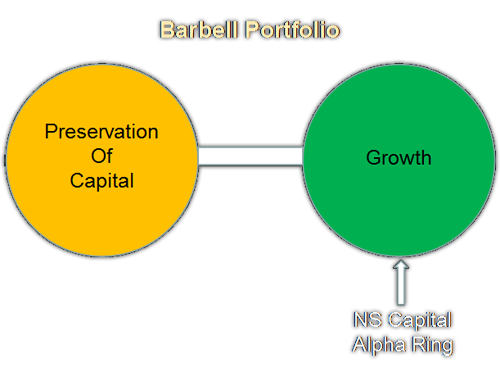The Barbell Strategy
Post on: 8 Август, 2015 No Comment

As rates rise, a smart move is to split your bond portfolio between very long and very short terms. Munis do this the best.
Barbells aren’t just for bodybuilding. This is the name of a smart bond strategy for when interest rates are rising, like now. To create a barbell bond portfolio, you buy obligations with maturities clustered at the two extremes of the yield curve–long and very short, usually a 50-50 split to start. This strategy gives you good interest from the long end (I’d go out ten years). From the short end you get the flexibility to produce quick cash for eventually purchasing other longer-term bonds, whose prices will be declining amid the escalating rates.
Such a maneuver is best accomplished with municipal bonds, which, for high-bracket taxpayers, yield more after taxes than U.S. Treasurys. One reason to use munis is that myriad good ones that pay well are available these days. This is particularly true for short-term munis, whose yields fluctuate to jibe with prevailing rates. What I have in mind are the floating-rate munis with rates that reset daily, weekly or monthly. Their principals stay at par value. Minimum purchase: $100,000. They are blessedly without bid/ask spreads; you buy them and put them back at par to the issuer whenever you want. (Brokers handling them take a negotiated fee from the issuer.)
No corporate equivalent to munis exists for retail invest-ors looking to invest short term. Commercial paper is the corporate equivalent of a muni floater, but it usually comes in slugs starting at $1 million. While you could park your short-term capital in Treasury bills, bought directly from the government to avoid brokers’ transaction costs, T bills yield less after taxes than munis.
Money market funds? They have expenses that annoyingly eat into your return. Tax-free money market funds stuffed with munis from your state illustrate the problem. (Out-of-state munis are exempt from federal taxes but not from your own state’s taxes; in-state bonds are free of both.) The Vanguard California Tax Exempt Money Market fund yields 2% on a seven-day SEC yield–the Securities & Exchange Commission’s mandated return figure, figuring in things like price changes to maturity, thus giving you a better picture of what you are earning. The Dreyfus California Tax Exempt Money Market yields 1.57%. These two yields are between four-tenths and nine-tenths of a percentage point less than the yield on a good floater. It’s not a huge gap, but the difference belongs in your pocket, not someone else’s.
Another alternative to floaters–yet one best avoided–is monthly auction rate munis, whose rates reset every 35 days or so. I believe you’ll get better returns with weekly floaters, which also have better liquidity and are more responsive to market changes because they are shorter term.
Among the best floaters are the Metropolitan Water District of Southern California weekly floating-rate bonds maturing July 1, 2020, issued in 2001. They yield 2.43%, which for a Californian in the highest federal tax bracket translates to 3.79% on a Treasury. (Note: The top federal bracket is a bit more than 36% when you allow for the itemized deduction clawback.) Should a rush to liquidate occur and the marketmaker be unable to handle the selling onslaught, Metropolitan Water and its ilk have credit lines with the banks available to be tapped.
The risk of floaters defaulting is historically minuscule. Even California’s Orange County didn’t stiff investors during its 1994 bankruptcy. Orange County’s short-term obligations never sank in value or skipped a beat in interest payments.

Like most other floaters Metropolitan Water has a superb credit rating. Moody’s rates its floaters Aa2/VMIG1; Standard & Poor’s has them at AA+/A-1+. The first designation, the one you’re likely familiar with, covers the borrower’s ability to pay interest and, in time, retire the principal. The second rating, VMIG1 or A-1+, evaluates the soundness of the backup credit line. Here VMIG1 and A-1+ denote the best quality.
Another good short-term muni: New York City General Obligation weekly floaters, maturing Aug. 1, 2031, rated Aa2/VMIG1 and AA/A-1+. These carry a letter of credit by BNP Paribas. They yield 2.43% versus Vanguard’s New York Tax-Exempt Money Market, yielding 1.99%, and the Dreyfus New York, at 1.46%.
The longer end of your barbell, ten years, will fluctuate in value with every Federal Reserve leak, inflation bulletin and unemployment report. The short end of your barbell, the floaters, won’t. I am not concerned with the names of the floaters you purchase as long as they have sterling credit quality and backup liquidity lines. Then you can comfortably wait for the Fed and bond market to decide the fate of interest rates.
Marilyn Cohen is president of Envision Capital Management, Inc. a Los Angeles fixed-income money manager and author of The Bond Bible. Find past columns at www.forbes.com/cohen .














